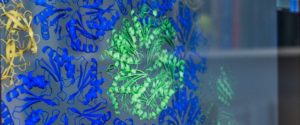 A team of researchers led by Cheryl Kerfeld, faculty affiliate in the Environmental Genomics & Systems Biology (EGSB) Division, have developed a new method to manipulate miniature factories found in bacteria that could someday lead to new medical, industrial, or energy applications. The factories, called bacterial microcompartments–or BMCs–are found in bacteria all over the world.
A team of researchers led by Cheryl Kerfeld, faculty affiliate in the Environmental Genomics & Systems Biology (EGSB) Division, have developed a new method to manipulate miniature factories found in bacteria that could someday lead to new medical, industrial, or energy applications. The factories, called bacterial microcompartments–or BMCs–are found in bacteria all over the world.
While flexible in variety and function, the factories can be tough to work with in the lab. In a recent study published in ACS Nano Letters, the researchers describe their new method for building the BMCs in test tubes, allowing for high levels of control (see overview in GIF below). Once made, they can change the electric charge on the inside of the factory walls (or shells of the BMCs) to attract desired cargo. The resulting custom factories can perform new functions, like producing renewable materials, such as biofuels, plastic, or rubber, or be used in various medical applications like disease targeting and imaging.




